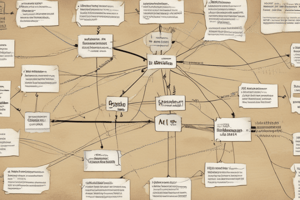Podcast
Questions and Answers
In project management, what does 'scope' refer to?
In project management, what does 'scope' refer to?
- The time and resources needed for the project
- The processes involved in creating the products of the project (correct)
- The educational and behavioral performance of children
- The integration with the school registration system
What is a 'deliverable' in a project context?
What is a 'deliverable' in a project context?
- The training and Data Migration phase
- The time estimation for the project
- The budget limitation
- A product produced as part of a project (correct)
Why is the integration with the school registration system excluded from the project scope?
Why is the integration with the school registration system excluded from the project scope?
- Due to security issues and time limitation (correct)
- Due to company needs from the system
- Due to budget limitation
- Due to educational and behavioral performance of children
Which phase of the project includes understanding the company needs from the system?
Which phase of the project includes understanding the company needs from the system?
What will be delivered by the end of this project?
What will be delivered by the end of this project?
What marks the conclusion of the project according to the text?
What marks the conclusion of the project according to the text?
What is the purpose of a Work Breakdown Structure (WBS)?
What is the purpose of a Work Breakdown Structure (WBS)?
At what level should the work breakdown stop according to the concept of WBS?
At what level should the work breakdown stop according to the concept of WBS?
What does SDLC stand for in the context of WBS?
What does SDLC stand for in the context of WBS?
What is the advantage of visually representing the scope of the project through a WBS?
What is the advantage of visually representing the scope of the project through a WBS?
Which task is not a part of the 'Iteration' phase as per the effect of process model on WBS?
Which task is not a part of the 'Iteration' phase as per the effect of process model on WBS?
What is the effect of Process Model on WBS related to?
What is the effect of Process Model on WBS related to?
In WBS, what does 'Requirement Engineering' involve?
In WBS, what does 'Requirement Engineering' involve?
'Project Scope' refers to which of the following?
'Project Scope' refers to which of the following?
Which model is recommended for projects with clear requirements, stable nature, and a focus on reusing existing components and assets?
Which model is recommended for projects with clear requirements, stable nature, and a focus on reusing existing components and assets?
Which advantage is associated with the Agile model, according to the given text?
Which advantage is associated with the Agile model, according to the given text?
What is a disadvantage of the Plan-driven model based on the information provided?
What is a disadvantage of the Plan-driven model based on the information provided?
Which factor leads to dependence on the availability of reusable components in Agile model?
Which factor leads to dependence on the availability of reusable components in Agile model?
What advantage is linked to the Evolutionary model as per the given information?
What advantage is linked to the Evolutionary model as per the given information?
In which scenario is the Spiral model recommended, based on the details provided?
In which scenario is the Spiral model recommended, based on the details provided?
Flashcards are hidden until you start studying
Study Notes
- Project scope refers to all work involved in creating a project's products and processes. It includes what is included and excluded from the project.
- A deliverable is a product produced as part of a project. The project will deliver a new website and mobile application for parents to access their children's educational and behavioral performance, integrating with a school registration system.
- However, the integration with the school registration system and mobile application delivery are excluded from the project due to security issues, time limitations, and budget limitations.
- Work Breakdown Structure (WBS) captures all tasks involved in a project, breaking down complex tasks into smaller tasks for estimation and management.
- It consists of different levels with specific tasks and durations, such as requirement engineering, design, implementation, integration, and testing.
- WBS also shows dependencies between tasks to help manage the project effectively.
- The process model (Waterfall, Evolutionary Spiral, Unified Process, Reuse, or Agile) affects WBS tasks' duration and dependencies.
- Clear requirements, stable projects, and big projects are suitable for plan-driven models, while risky, complex projects and projects focusing on reusing components are suitable for agile models.
- Plan-driven models offer advantages like a visible process, full documentation, continuous feedback, risk management, and total flexibility, but also disadvantages like late customer feedback, difficult changing, a hidden process, high cost, and more time needed.
- Agile models offer advantages like continuous feedback, total flexibility, incremental documentation, reduced time, reduced cost, enhanced software quality, and easy changing, but also disadvantages like poor code structure and high maintenance.
Studying That Suits You
Use AI to generate personalized quizzes and flashcards to suit your learning preferences.




